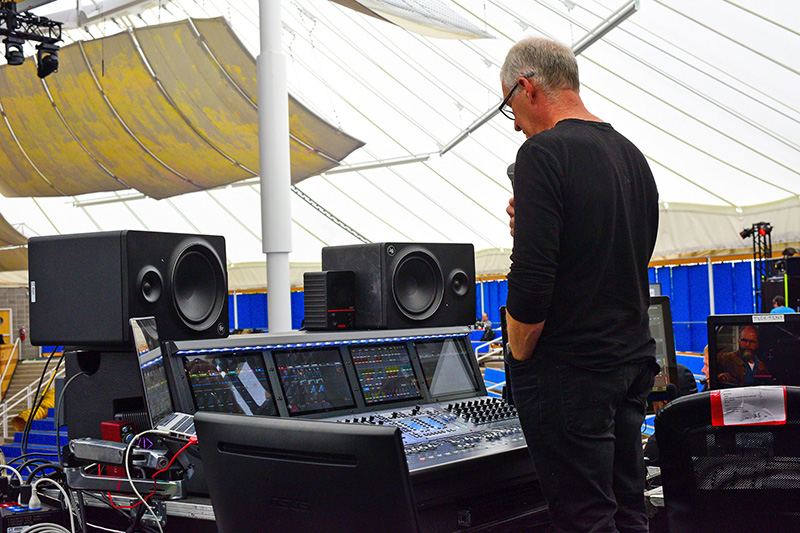Recently, I was charged with mixing a massive television event that included a large orchestra, a traditional band ensemble; drums, bass, guitars keys, a huge percussion rig, Pro Tools playback, etc., with upwards of 30 handheld vocal microphones along with presenting all of the production elements for the show; introductions, video rolls, stage announcements. “Oh, and while you’re mixing it, let’s record it in multitrack form too, OK?” Um … OK.
While the event was in full swing, I had a kind of an “in awe” moment. No, not at how great it was all sounding or the caliber of the musicianship, which was incredible by the way. No, I had a moment of awe at just how effortlessly modern mixing technology was allowing me to handle a channel count approaching 200 on a mixing console that offered up a whopping 32 faders.
I looked down and took stock of what I was sitting in front of in terms of capability versus its physical presence. It suddenly dawned on me that if this console was built using analog technology and hardware but was required to offer the same input and output capacity, I physically would not be able to operate it – 96 mix buses plus EQ and pre-amp controls along with group assignment buttons, faders, and so on would create a channel strip physically too long or deep to actually reach past about aux 20.
In addition, with 192 channels, I would have needed roller skates to get from the music inputs to the production inputs quick enough to make the changes, let alone the inability to actually mix the event. And recording it all in discrete multi-track form? Forget about it. The show alone would have required a couple of mix engineers, maybe even three, to mix the event, not to mention record it.
Come to think of it, that’s not far off of what we used to actually do for shows that were lesser in scale. But here I sat. One person in total control, mixing stress free. Kind of on cruise control.
Powerful Stuff
So, what was the secret recipe? Well, it lies in the awesome combined power of five feature elements on some of today’s digital mixers: 1) User-defined, snapshot-recallable fader layouts, 2) Audio submasters, 3) VCA (DCA) masters, 4) Matrices, and 5) The ability to spill a set of sources assigned to any of these buses in conjunction with the ability to quickly “bank safe” any channel strip and lock it in place while navigating to other locations in the console for quick adjustments and then immediately snap back to the recalled top layer layout.
For example, as I’ve mentioned in previous articles on this subject, I use audio submasters as a master volume for a “family” of instruments and processing returns. A common example is a drum submaster that would contain all drum inputs, all drum parallel compression sets, and all drum processing. The same for keyboards, or electric guitars, or backing vocals, etc. A master volume for a blended set of inputs and processing represented by one fader for each family on the top layer of the console. Stems representing the building blocks of the music.
This type of bus used in conjunction with “spill” functionality provides an immediate collation of all of the inputs assigned to that audio submaster brought to the top layer of the console for immediate access and editing. Used in conjunction with bank safe, currently vital channels can be locked to the event on the top layer while spilling in order to not lose sight of those channels you need to in order to continue mixing.
A similar approach applies to my use of VCAs. Remember, a VCA fader is essentially a master remote control fader for any number of input or output faders assigned to it. For example, in the case of say, a guitar player, I’m likely assigning all of his/her input faders to a single VCA regardless of what this musician is playing at any given time. Once done, I now have one single fader that represents him/her, on the top layer, that I can immediately adjust volume for and ride at any point in the performance.
But what if I need to quickly adjust the EQ on that keyboard this musician plays for 16 bars of that one song? Spill his/her VCA and it snaps to the top layer along with this musician’s other inputs under the control of this VCA regardless of where they might be scattered throughout the input layers. EQ, release the spill, and you’re back to work.
Additional Plusses
In addition, if I’m using a PA system that is driven by multiple sources from the console – maybe matrixes for the loudspeaker arrays and auxiliaries for the subwoofers, for example – I have a single VCA that’s assigned to all of those matrix and aux masters, allowing me to have one single fader on the console that represents the “volume” of the PA system.















